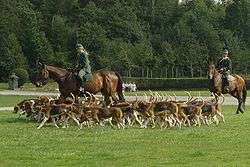English Foxhound
 | ||||||||||||||||||||||||||
| Other names | Foxhound | |||||||||||||||||||||||||
|---|---|---|---|---|---|---|---|---|---|---|---|---|---|---|---|---|---|---|---|---|---|---|---|---|---|---|
| Origin | Great Britain - England | |||||||||||||||||||||||||
| ||||||||||||||||||||||||||
| ||||||||||||||||||||||||||
| Domestic dog (Canis lupus familiaris) | ||||||||||||||||||||||||||
The English Foxhound is one of the four foxhound breeds of dog. It is a cousin of the American Foxhound. They are scent hounds, bred to hunt foxes by scent.
Description
Appearance

The breed standards' guidelines for showing English Foxhounds requires them to be 21–25 inches (53–64 cm) tall at the withers.[1] The skull is wide and the muzzle is long. The legs are muscular, straight-boned, and the paws are rounded, almost cat-like. The English Foxhound comes in any hound color, most often tricolor, tan, red, or black with a white base.
Temperament

The English Foxhound is a pack hound, therefore, it gets along well with other dogs and enjoys human companionship. It gets along with horses, children, and other pets, as it is a gentle, social, and tolerant breed. It is an active breed that enjoys hunting foxes and has the stamina to run all day with few breaks.
Health and lifespan
There are very few health problems in this breed. Occasionally seen are chronic hip dysplasia, renal disease, and epilepsy. The breed's lifespan is typically 10–13 years.
History
The English Foxhound was created in the late 16th century, as a result of the perception of the depletion of deer in England. Nobles and royalty had hunted deer for both food and sport, using the Deerhound or Staghound for this purpose. During the reign of Henry VIII, it was perceived that a new prey was needed, and the fox was selected. The English Foxhound was then created by a careful mixing of the Greyhound, for speed, the Fox Terrier, for hunting instinct, and the Bulldog, for tenacity in the hunt.
During the British Raj, English Foxhounds were exported to India for the purpose of jackal coursing,[2] though due to the comparatively hotter weather, they were rarely long lived.[3] Foxhounds were preferred for this purpose over greyhounds, as the former was not as fast, and could thus provide a longer, more sporting chase.[4]
Studbooks for the English foxhound have been kept since the 18th century. Breeding lines and the work of people involved in breeding hounds is extremely important in the continual development of this working breed. Puppy shows are important events in the hunting calendar and allow the local hunt followers and visiting hound breeders examine the latest generation from the hound pack. The International Foxhound Association was created in 2012 for the promotion of the English Foxhound as a breed.
References
- ↑ "English Foxhound" (PDF). FCI. Retrieved 28 March 2015.
- ↑ Thirteen years among the wild beasts of India: their haunts and habits from personal observation with an account of the modes of capturing and taming elephants by George P. Sanderson, published by Asian Educational Services, 2000, ISBN 81-206-1464-X
- ↑ The living animals of the world; a popular natural history with one thousand illustrations Volume 1: Mammals, by Cornish, C. J., 1858-1906; Selous, Frederick Courteney, 1851-1917; Johnston, Harry Hamilton, Sir, 1858-1927; Maxwell, Herbert, Sir, published by New York, Dodd, Mead and Company
- ↑ A monograph of the canidae by St. George Mivart, F.R.S, published by Alere Flammam. 1890
External links
| Wikimedia Commons has media related to English Foxhound. |